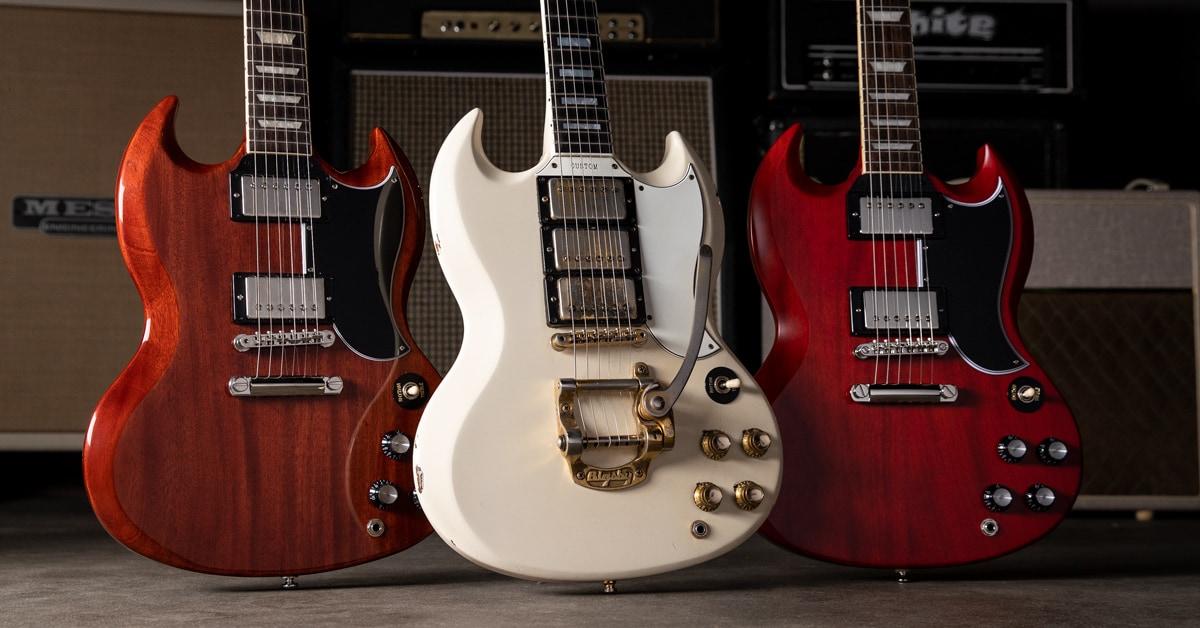Sixty years after its introduction, the SG has become one of Gibson's best-selling electric guitars of all time—and for good reason. Lighter and thinner than a Les Paul Standard or Custom, it's a nimbler instrument and decidedly less complicated—it ditches the carved top in favor of a more utilitarian design. This guide will help you cut through the clutter to find the best SG for you.
Table of Contents
Buying an SG – Epiphone or Gibson?
Comparing SG Models
How to Choose the Best Gibson SG
How to Choose the Best Epiphone SG
How to Buy a Vintage SG
Buying an SG – Epiphone or Gibson?
Quick question: Which company is older—Gibson or Epiphone? If you answered Epiphone, you're right. Its roots go back to 1873, when Anastasios Stathopolous began making lutes and fiddles in Turkey before settling in New York at the turn of the century. Upon his death, his son Epaminodas "Epi" took the reins. Epiphone added guitars to its lineup in 1928 to compete with its biggest rival—Gibson. The two companies battled head-to-head, but Gibson had more muscle, eventually purchasing Epiphone in 1957, and moving its headquarters to Kalamazoo, Michigan.
In 1969, Ecuadorian beer and cement company ECL bought Gibson/Epiphone. Many felt that the quality of the guitars suffered as a result. Whether that was accurate or just perception is up for debate. After rebranding itself as the Norlin Music Company, production of Epiphone guitars went overseas—first to Japan, later China and Korea.
Today, Gibson is led by CEO Cesar Gueikian. Under their leadership, Gibson and Epiphone have launched new SG lines with unprecedented quality and tones, from exacting reissues to updated models with game-changing features. With these offerings, there's never been a better time to buy an SG.
Comparing SG Models
|
Model |
Body Wood |
Fretboard |
Pickups |
Neck Shape |
Weight Relief |
Enhanced Electronics |
Price* |
|
Mahogany |
Rosewood |
Burstbucker 61R/61T |
SlimTaper |
None |
No |
$1,999.00 |
|
|
Mahogany |
Rosewood |
490R/490T |
Rounded |
None |
No |
$1,799.00 |
|
|
Mahogany |
Ebony |
490R/490T |
Rounded |
None |
No |
$1,999.00 |
|
|
Mahogany |
Indian Rosewood |
P-90 |
SlimTaper |
No |
Handwired with Orange Drop Caps |
$1,599.00 |
|
|
Mahogany with maple top |
Ebony |
Burstbucker Pro |
Asymmetrical SlimTaper |
Ultra-Modern |
Yes (coil-split) |
$2,499.00 |
|
|
Mahogany with maple top |
Ebony |
Burstbucker Pro |
SlimTaper |
No |
Yes (coil tap) |
$3,499.00 |
|
|
Gibson Custom Shop 60th Anniversary 1961 Les Paul SG Custom VOS |
Mahogany |
Ebony |
Custombucker 3x |
Slim ’60s |
None |
Handwired with vintage components |
Call for price |
|
Mahogany |
Ebony |
490R/498T |
’60s SlimTaper |
No |
Handwired with CTS pots |
$4,799.00 |
|
|
Mahogany |
Rosewood |
Custombucker 3x |
1964 Fat Neck |
No |
Handwired with Orange Drop caps |
$5,999.00 |
|
|
Mahogany |
Rosewood |
Custombucker |
Mid-’60s Slim |
None |
Handwired with CTS pots & PIO caps |
$6,999.00 |
|
|
Mahogany |
Ebony |
ProBucker 3x |
’60s SlimTaper |
No |
Yes (CTS pots, Mallory caps) |
$1,499.00 |
|
|
Mahogany 2-piece) |
Rosewood |
Gibson Custombucker (USA) |
1960s SlimTaper |
No |
Yes (CTS pots, Black Beauty caps) |
$1,299.00 |
|
|
Mahogany |
Ebony |
ProBucker |
’60s SlimTaper |
No |
No |
$699.00 |
|
|
Mahogany |
Indian laurel |
Alnico Classic PRO |
’60s SlimTaper |
No |
No |
$599.00 |
|
|
Mahogany |
Laurel |
Epiphone 650R/700T |
’60s SlimTaper |
No |
No |
$349.00 |
|
|
Mahogany |
Ebony |
Fishman Fluence |
SlimTaper |
Yes |
Yes (multi-voice) |
$1,099.00 |
|
|
Mahogany with maple veneer |
Ebony |
ProBucker |
Asymmetrical SlimTaper |
No |
Yes (coil splitting, phase switching, treble-bleed circuit) |
$749.00 |
Pricing as of January 2026*
How to Choose the Best Gibson SG
Today, Gibson makes over 25 different SG models—it's a lot to wade through. Fortunately, Gibson organizes its SGs in four different collections: Original, Modern, Artist and Custom Shop.
Gibson SG Original Collection
CEO Cesar Gueikian describes his position as "custodian to Gibson and steward of its future." There's no better example than the Original Collection, featuring US-made instruments with heritage style and sounds.
Gibson SG Standard '61
Why It's Cool: This model channels the early ’60s SG with vintage-voiced pickups.
Key Features:
- SlimTaper neck offers classic ’60s-style playability
- ’61R and ’61T pickups
- Guitar Center-exclusive Blue Sky, Sunshine and Tobacco Sunburst Perimeter finishes
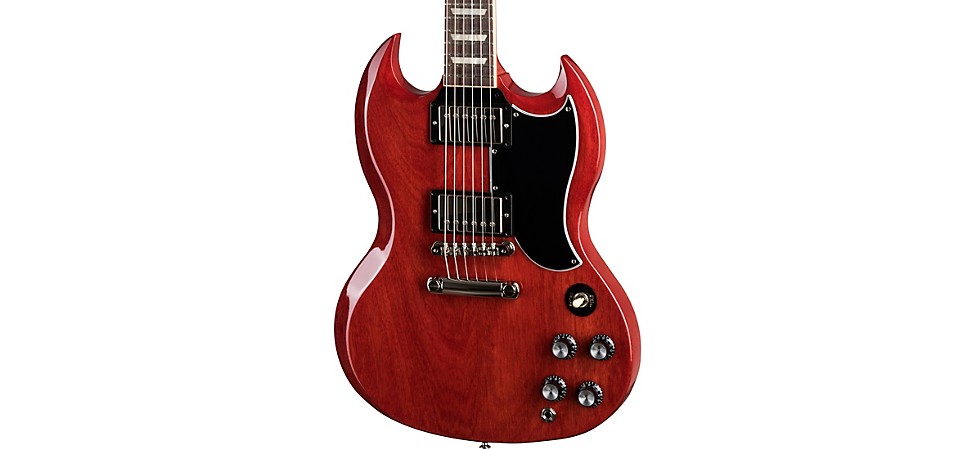
Shop Now: Gibson SG Standard '61
The Gibson SG Standard ’61 replicates the first SG-style guitar out of the gate. That includes a mahogany body, mahogany neck and rosewood fretboard with acrylic trapezoid inlays. Burstbucker 61R/T pickups have unbalanced coils, matching vintage humbuckers that were wound without a counter. Expect an edgier top end and an overall brighter sound—think "Thunderstruck" by AC/DC—Burstbuckers can scream. This SG is available with a stopbar tailpiece, or two different vibrato systems. The Sideways Vibrola moves in the direction of your pick stroke. Original units were fussy; fortunately, Gibson has re-engineered this Vibrola so that strings faithfully return to pitch. The nickel-plated tailpiece cover has an Art Deco look that would fit right on the Chrysler Building. The Maestro Vibrola is a mid-60s fulcrum-based design with a simpler—but just as effective—mechanism. It has an engraved lyre on the cover plate. In 2023 Gibson introduced a slew of vibrant new color options to the stopbar model, including Silver Mist, Pelham Blue and Translucent Teal among other eye-catching finishes.
Gibson SG Standard
Why It's Cool: A contemporary classic, this SG nails the essentials with punchy pickups and no-nonsense hardware.
Key Features:
- Rounded neck profile offers a thicker grip
- Classic hardtail is great for tuning stability
- Alnico II pickups deliver warm, articulate tones

Shop Now: Gibson SG Standard in Ebony
The Modern Collection's Gibson SG Standard incorporates elements of an original ’66 in its build. The neck has a rounder profile than early model SGs; it joins the body at the 19th fret for enhanced stability. You can't miss the bigger batwing pickguard, or the 490R/T humbuckers that conjure the rock-oriented aggressive tones of the late ’60s. They're wax-potted to stifle high-gain squeal. This SG Standard comes with Grover Rotomatic tuners and a Nashville bridge, offering a fuller range of saddle movement for enhanced intonation. As with the Standard '61 model, in late 2023 Gibson introduced a host of new color options including a striking Cardinal Red Burst, classic TV Yellow and always eye-catching Pelham Blue Burst.
Gibson SG Standard Dark
Why It's Cool: It’s a classic SG Standard dressed for the dark side, with a moodier stage presence.
Key Features:
- All-mahogany body and rounded neck profile
- Snappy ebony fingerboard
- Same pickups and electronics as the SG Standard
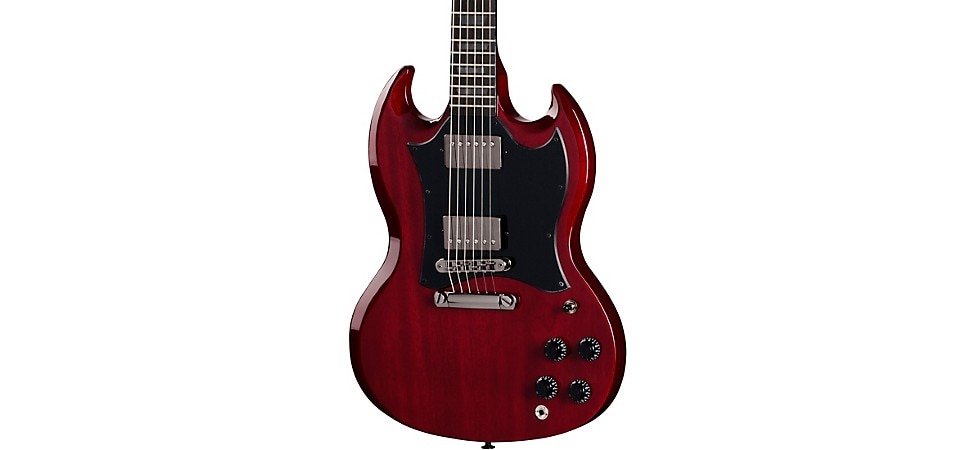
Shop Now: Gibson SG Standard Dark in Aged Cherry
Though it shares the bones and soul of the SG Standard—same 490 pickups, same rounded neck, same no-frills wiring—the SG Standard Dark brings a whole new attitude. The all-black hardware, dark inlays and ebony fingerboard give it a bold, snarling look— perfect for players who want SG tone in a sharper suit.
Gibson SG Special
Why It’s Cool: P-90 pickups lend this SG an alternative voice from the usual humbucking fare.
Key Features:
- Bound rosewood fingerboard
- Vintage-type wraparound bridge
- Nitrocellulose finish

Shop Now: Gibson SG Special
The Gibson SG Special looks like it’s straight out of the early ’60s, sporting a stripped-down design that screams rock ’n’ roll. At the heart of this guitar are a pair of snarling P-90 single-coil pickups, noted for their punchy midrange and clear top end. Even under gain, the sound is defined and articulate—perfect for laying into big chords through a sizzling half stack. The term “workhorse” gets thrown around a lot, but the SG Special truly offers a look and sound worthy of the moniker.
Gibson SG Modern Collection
Classic guitars from the golden age of Gibson offer their own rewards, but sometimes you need more current features. This collection borrows classic elements from the SG's past, but adds refinements for those who require more versatility and enhanced playability. You'll see different specs in appearance, electronics and construction, but the DNA remains Gibson.
Gibson SG Modern
Why It's Cool: With a contoured heel, compound-radius fingerboard and coil tapping, this SG is built for today’s shredders.
Key Features:
- Asymmetrical, compound-radius SlimTaper neck
- Push-pull pots with coil splitting
- 24 frets for a full two-octave range
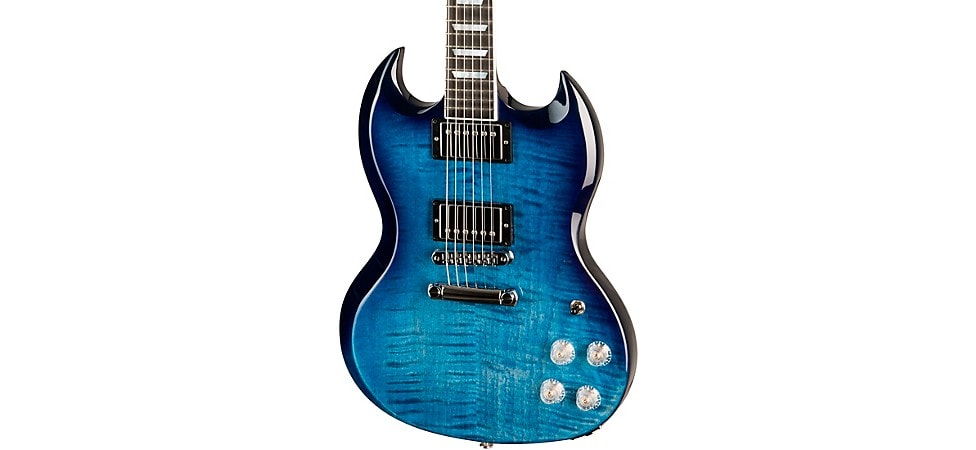
Shop Now: Gibson SG Modern
The Gibson SG Modern breaks the mold with an AA flame maple top, a feature normally found on Les Paul Standard. That's one sign that this Gibson has a few tricks up its sleeve. It features BurstBucker Pro pickups made with stronger magnets—Alnico V vs. Alnico II— that are fatter and edgier than a vintage P.A.F, and altogether quieter, too. A 24-fret neck makes the SG Modern a best-bet for metal and hard rock; its asymmetrical profile follows the natural contours of your hand for playing comfort. The compound radius ebony fingerboard is rounder by the nut for chording ease, but flatter at higher registers for soloing speed.
Gibson SG Supreme
Why It’s Cool: Perennial Solid Guitar style meets progressive playability.
Key Features:
- 24-fret, compound-radius fingerboard
- Push/pull coil tapping
- Resurrected 1940s-style headstock inlay

Shop Now: Gibson SG Supreme
Some players just want to soar, and the Gibson SG Supreme gives them the platform they need to fly. The SlimTaper neck shape is a forever favorite among players of diverse taste. Known for its fast, comfortable feel, it’s equally suited to cowboy chording and shredding. The compound-radius fingerboard is also rounder down low to put your hand in an ergonomic position to grab chords, then it starts to flatten out up the neck to more easily fret single-note runs with plenty of room to bend.
Looks-wise, the SG Supreme borrows from classic Custom styling with its gold hardware and block-type inlays, for an aesthetic that’s both timeless and fresh.
Gibson SG Custom Shop Collection
Based in Nashville, the Gibson Custom Shop creates instruments made to exacting detail by the company's most skilled luthiers. Every spec is carefully considered. Some upper-end models offer unique finish options, hardware matches, one-off designs and more. In any case, with a Gibson Custom SG, you'll own the best of the best.
Gibson Custom Shop 60th Anniversary 1961 Les Paul SG Custom
Why It's Cool: This triple-pickup Custom Shop reissue captures the elegance and bite of the original Les Paul SG Custom in glorious vintage detail.
Key Features:
- Gold hardware delivers upscale aesthetics
- Three Custombucker pickups
- VOS finish and construction mirror the 1961 original for maximum vintage authenticity
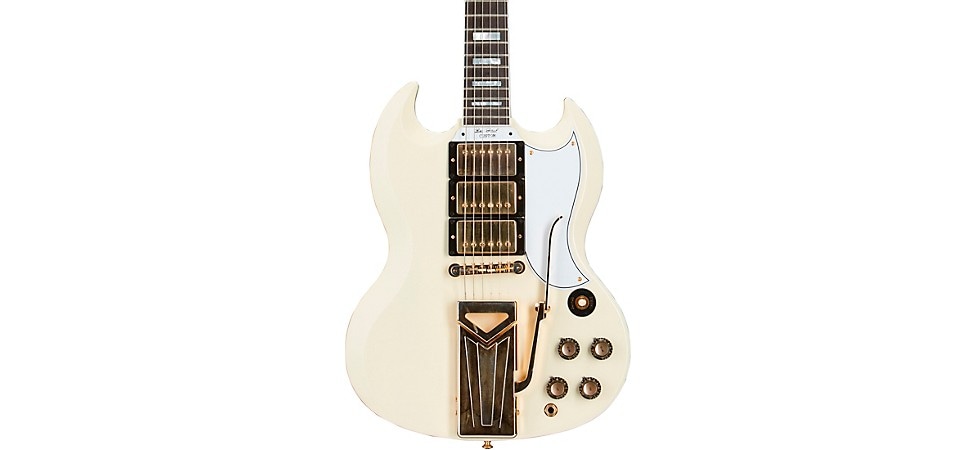
Shop Now: Gibson Custom 1961 SG Les Paul Custom Reissue VOS
One of the first adopters of the SG was Sister Rosetta Tharpe. Her guitar might have appeared angelic, but when it came to the gospels, she rocked them raw. The Gibson Custom 60th Anniversary 1961 SG Les Paul Custom VOS is a revelation in classic white with gold hardware. Move the Sideways Vibrola bar out of the way if you're not feeling it, but when the spirit hits you, you have to shake that thing.
Gibson Custom SG Custom
Why It’s Cool: If you’ve fallen in love with the legendary black Les Paul Custom, you can also get it in SG form.
Key Features:
- Dressed-up black, gold and white “tuxedo” aesthetic
- Versatile humbuckers conquer jazz to metal
- Medium-jumbo frets on an ebony fingerboard

Shop Now: Gibson Custom SG Custom
Like it’s suited up for a ritzy gala, the Gibson Custom SG Custom is classy, cool and built to give your playing confidence. It’s got a pair of 490R (neck) and 498T (bridge) humbuckers, which are among Gibson’s most sonically diverse pickups, capable of everything from smooth, round clean tones to searing high-gain crunch. The ’60s SlimTaper neck with a 12" fingerboard radius is a dream to play, too, and while guitar necks are rarely a “one-size-fits-all,” the SG Custom’s buttery playability conforms to a range of styles.
Gibson Custom SG Standard Fat Neck 3-Pickup
Why It’s Cool: This Guitar Center-exclusive SG Standard is uniquely spec’d for a one-of-a-kind look, sound and feel.
Key Features:
- Thick, round, C-shaped neck profile
- Middle pickup wired out-of-phase with the neck in position 2
- Available in Sparkling Burgundy, Candy Blue, Antique Metallic Teal and Double Gold

Shop Now: Gibson Custom SG Standard Fat Neck 3-Pickup in Double Gold
The Gibson Custom Shop SG Standard Fat Neck 3-Pickup electric showcases the brand’s finest craftsmanship alongside a daring feature set. Its Fat Neck is definitely for players who prefer substantial, vintage-style profiles, while the addition of a third humbucker squeezes even more out of the SG’s already-versatile sound. Cap it all off with your choice of a stunning finish that’s bold, but not gawdy, and this one’ll be sure to turn heads.
Gibson SG Murphy Lab Collection
When Tom Murphy heard The Who's Live at Leeds in 1970, he immediately went out and bought an SG Junior to sound like Pete Townshend. Thus began a never-ending passion for vintage guitars. Murphy has spent decades developing techniques to make new instruments match up to old favorites. The Murphy Lab is a division in the Gibson Custom Shop where his trained team creates SG models with four levels of wear: Ultra Light, Light, Heavy and Ultra Heavy.
Gibson Custom Shop Murphy Lab SG Standard Reissue
Why It's Cool: Murphy Lab aging gives this SG a road-worn vibe and vintage mojo that looks and feels decades deep.
Key Features:
- Light relic finish creates a broken-in aesthetic
- Nitrocellulose lacquer and aged hardware
- Historic-spec pickups and wiring offer articulate, era-accurate tone
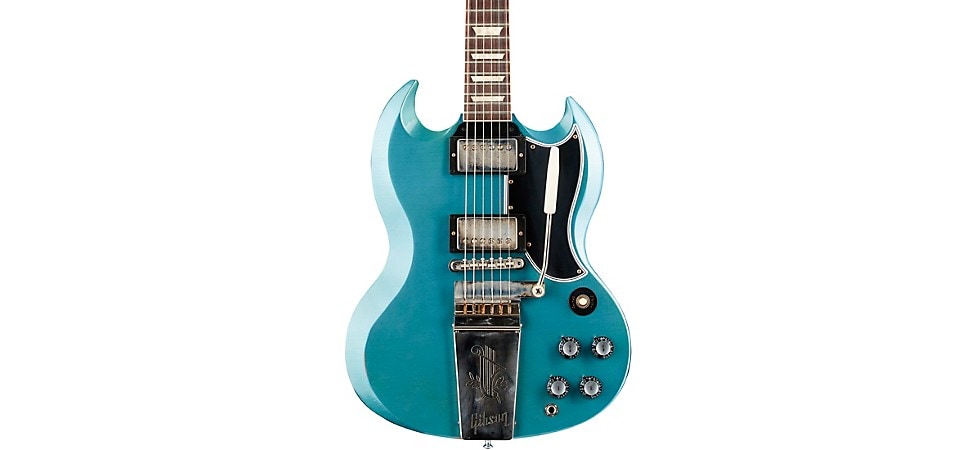
Shop Now: Gibson Custom Murphy Lab 1964 SG Standard Reissue Maestro with Vibrola Light Aged
The Gibson Custom Murphy Lab 1964 SG Standard With Maestro Vibrola is a prime example. Choose Ultra Light aging if you prefer few signs of playing wear. It gives the appearance of a guitar kept in a case under the bed for decades. Heavy aging simulates a life on the road with the scars of 50+ years of use and abuse.
Browse our full collection of Gibson Custom Murphy Lab guitars.
How to Choose the Best Epiphone SG
Epiphone relaunched its line of SG guitars in 2020, improving the quality, fit and finish of these more accessible instruments. For a new player, an Epiphone is an outstanding first guitar that lasts. There's plenty in the line to appeal to pros, too.
Epiphone SG Original Collection
Coming closer than ever to matching the Gibson aesthetic, Epiphone's Original Collection pays tribute to those Kalamazoo classics in a completely authentic way. The designs are based on Gibson blueprints and incorporate period-correct specs.
Epiphone Inspired by Gibson Custom 1963 Les Paul SG Custom with Maestro Vibrola
Why It's Cool: This vintage-inspired SG delivers classic rock tones and Vibrola shimmer without breaking the bank.
Key Features:
- SlimTaper neck and bound fingerboard nod to ’60s Gibson feel
- Iconic Gibson-style “open book” headstock
- Three Gibson Custombucker pickups
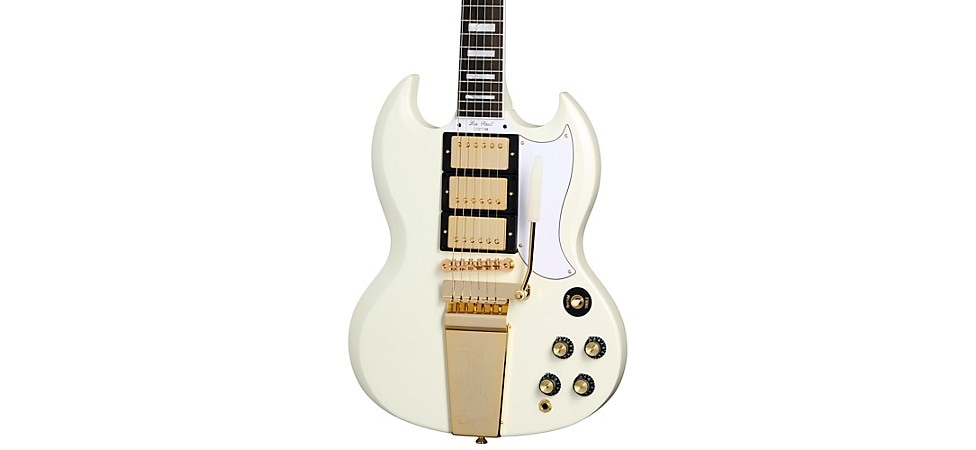
Shop Now: Epiphone Inspired by Gibson Custom 1963 Les Paul SG Custom with Maestro Vibrola
The 1963 Les Paul SG Custom with Maestro Vibrola stands out as a pinnacle of vintage-inspired craftsmanship. Collaboratively designed with the Gibson Custom team, this guitar exudes elegance, boasting features like the iconic bound "open book" headstock with split-diamond inlay, VOS Classic White finish over a slim mahogany body, and gold hardware, all meticulously faithful to its historical counterpart. Of course, this instrument plays exceptionally well thanks to the SlimTaper one-piece mahogany neck with bound ebony 12” fretboard with Medium Jump frets. Beyond its stunning aesthetics and effortless playability, the '63 LP SG Custom delivers classic, rich tone through a trio of Gibson Custombucker humbucking pickups, featuring alnico magnets, enamel coated wire, and uneven winding akin to the originals. Wired with CTS pots, Mallory caps, and a Switchcraft toggle switch, this instrument promises an authentic vintage experience.
Epiphone Inspired by Gibson Custom 1964 SG Standard Reissue With Maestro Vibrola
Why It's Cool: This meticulously crafted reissue delivers vintage SG tone, Gibson USA pickups and a full-on Lyre Vibrola tailpiece for period-correct feel and flair.
Key Features:
- 1960s SlimTaper neck and long neck tenon
- Gibson Custombucker pickups and Black Beauty caps
- Gibson-style “open book” headstock
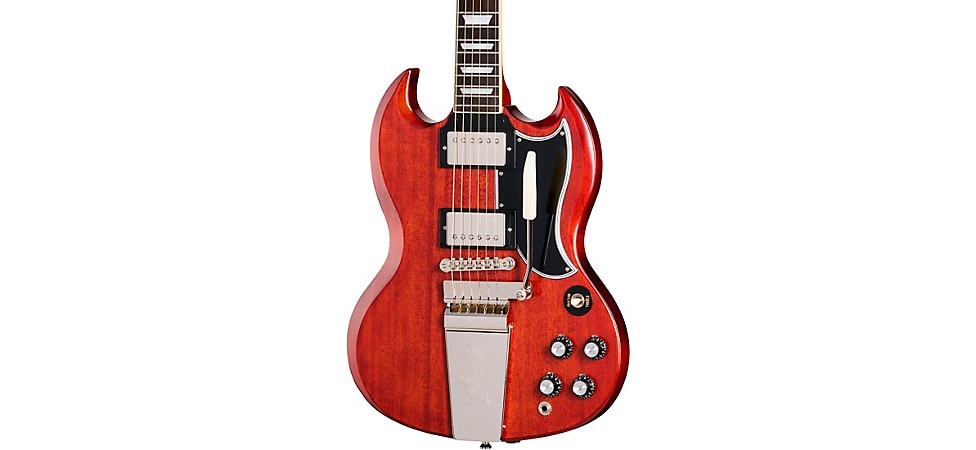
Shop Now: Epiphone Inspired by Gibson Custom 1964 SG Standard Reissue With Maestro Vibrola in Cherry Red
Created in collaboration with Gibson Custom, the 1964 SG Standard Reissue is Epiphone’s most faithful SG reissue yet. It sports a one-piece mahogany neck, bound rosewood fingerboard and a long-style Lyre Vibrola with the unmistakable engraving. Other vintage cues include double-ring tuners, aged mother-of-pearl inlays and nickel hardware. If you’re after a mid-’60s SG sound and feel without crossing into Custom Shop pricing, this is the one to get.
Epiphone SG Custom
Why It's Cool: Classic SG Custom aesthetics meet solid ProBucker tone and modern Epiphone reliability.
Key Features:
- Two Epiphone ProBucker pickups
- 1960 SlimTaper C neck profile
- Includes premium Epiphone gig bag
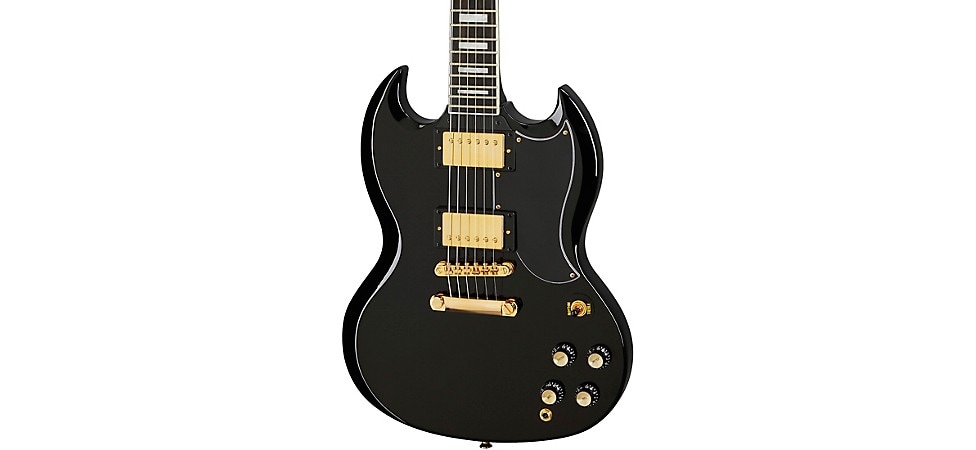
Shop Now: Epiphone SG Custom
Gibson first reserved its 5-ply Split Diamond headstock inlay for high-end instruments like the Super 400 and the ’54 Les Paul Custom. Get the same look for less with the Epiphone SG Custom. Other upscale appointments include an ebony fingerboard and gold hardware.Epiphone's Alnico Classic PRO humbuckers are made with higher strength magnets for more drive, but they're just as capable dimed down for jazz and other genres.
Epiphone SG Standard
Why It's Cool: A solid, no-frills SG that captures the spirit of early hard rock and blues with a vintage look.
Key Features:
- ’60s SlimTaper C neck shape
- Bound fingerboard
- Premium gig bag included

Shop Now: Epiphone SG Standard
Angus Young's guitar sound is one of the best around. The AC/DC rocker plays (and slays) a ’68 SG with larger-than-life tones. Epiphone's SG Standard is just as capable with Alnico Classic PRO pickups that get grittier at higher volumes. Young's wicked vibrato comes from his hands, not hardware; this SG keeps strings stable with a LockTone Stop Bar and tune-o-matic bridge. An old-school "pineapple crown" inlay tops the headstock. Modern touches include high-ratio Epiphone deluxe tuners and a neck with rolled edges for comfort.
Epiphone SG Tribute Plus
Why It’s Cool: Designed for beginner and intermediate players, this SG proves great style, feel and sound doesn’t have to cost a fortune.
Key Features:
- Flamed maple veneer in Cherry Burst, Ebony Burst and Vintage Sunburst
- Sloped Kalamazoo headstock shape
- Epiphone hardshell case available separately
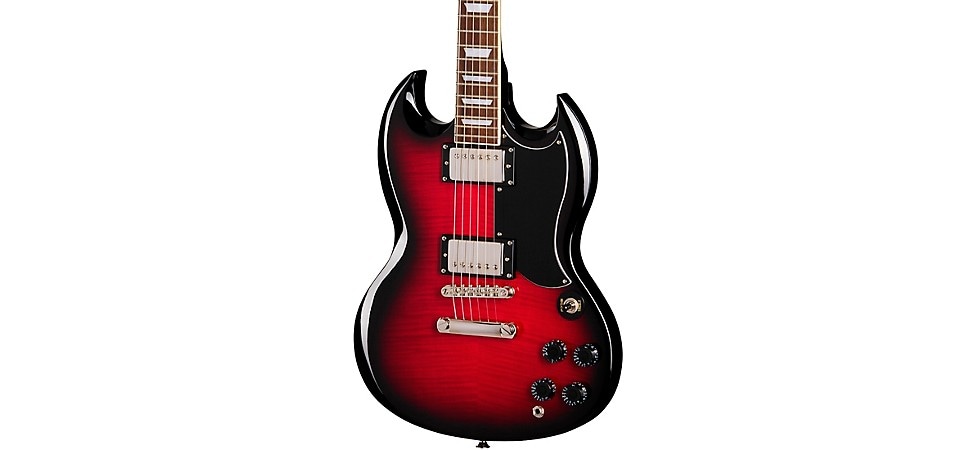
Shop Now: Epiphone SG Tribute Plus in Cherry Burst
The Epiphone SG Tribute Plus manifests the spirit of the very first Solid Guitars, putting a cool, contemporary twist on its mahogany silhouette with a slick flame top in three distinct finishes. It still sports plenty of classic SG traits, though, such as a half-face pickguard and bound fingerboard with trapezoid inlays, so it doesn’t stray too far from its legendary heritage. Playability-wise, the ’60s SlimTaper neck profile offers impressive comfort and speed; newbies should be encouraged by the guitar’s accessibility as they develop their chops. Tonally, the SG Tribute Plus is powered by a pair of Epiphone 700T (bridge) and 650R (neck) humbuckers, featuring rock-ready ceramic magnets for hearty, full-throated sonics.
Epiphone SG Modern Collection
You can respect SG history without being a slave to the ’60s. Epiphone's Modern Collection pairs classic style with player-friendly features like faster necks and updated fits and finishes.
Epiphone SG Prophecy
Why It's Cool: The Prophecy SG pairs Fishman Fluence humbuckers with fast access and dark aesthetics for progressive players.
Key Features:
- Multi-voice Fishman Fluence pickups
- Asymmetrical SlimTaper neck with jumbo frets
- ’60s-style Kalamazoo headstock shape
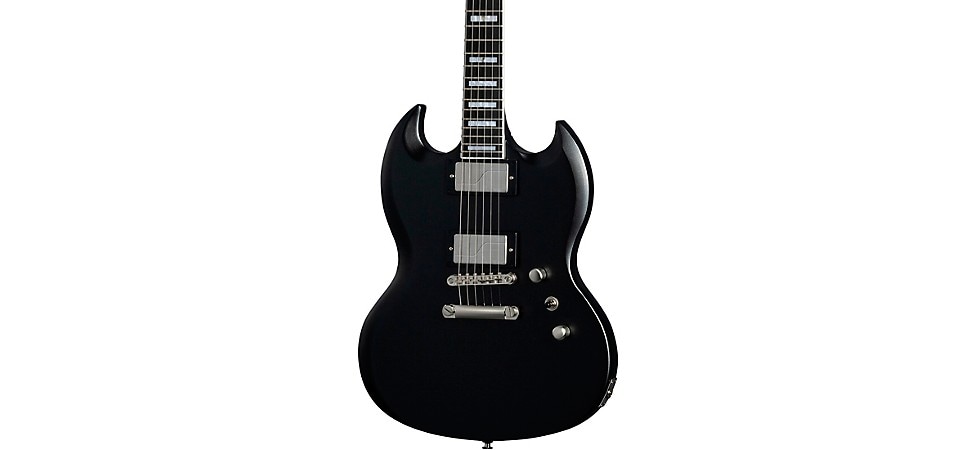
Shop Now: Epiphone SG Prophecy
The phrase "high performance" is frequently thrown around in guitar circles, but it's an apt description of the Epiphone SG Prophecy. We could start with the Fishman Fluence humbuckers—they're noise free, making this SG one of the best for recording. The pickups can be voiced three ways with push/pull controls: vintage humbucker, modern high-gain active humbucker and a split single-coil sound. Math rockers will find the 24-fret asymmetrical neck perfect for angular, progressive riffs. Grover locking tuners, mother-of-pearl inlays, knurled metal knobs and a maple top capped with AAA flame maple veneer are more reasons the Prophecy might be in your future.
Epiphone SG Modern Figured
Why It’s Cool: Epi’s SG Modern Figured offers some of the best bang for your buck from any Solid Guitar.
Key Features:
- Grover Rotomatic locking tuners
- Coil splitting and phase-switching electronics
- AAA figured maple veneer

Shop Now: Epiphone SG Modern Figured in Purple Burst
A souped-up, high-powered riff machine, the Epiphone SG Modern Figured caters to budget-minded guitarists without compromising performance. For acrobatic playability, the Asymmetrical SlimTaper neck carve maximizes comfort on both the bass and treble sides, at any position along the 24-fret ebony fingerboard. Sonically, each pair of volume and tone knobs can be pulled up to activate coil splitting and phase switching, respectively. Plus, the volume controls’ treble-bleed circuits maintain high frequencies when rolled off, so you can explore a complete range of sounds with level alone. Other premium appointments include locking tuners, a Graph Tech NuBone nut and, of course, a lovely figured maple top.
How to Buy a Vintage SG
Sometimes a vintage Gibson SG can be worth its weight in gold, especially if all the specs are correct. Before offering up an instrument, we thoroughly inspect it to spot repairs, modifications, refinishes or anything not original. But keep in mind that a guitar doesn't have to be 100% original to play and sound superb. Our vintage team is just as excited about SGs as you; rest assured that we'll do the work to ensure that there are no surprises.
We hope you've enjoyed this deep dive into all things SG. Come in to your local store to explore more, check out our extensive online selection of Gibson and Epiphone SGs, or give our Contact Center a call to find a Gear Adviser who shares your passion in finding the perfect guitar
.jpeg)







